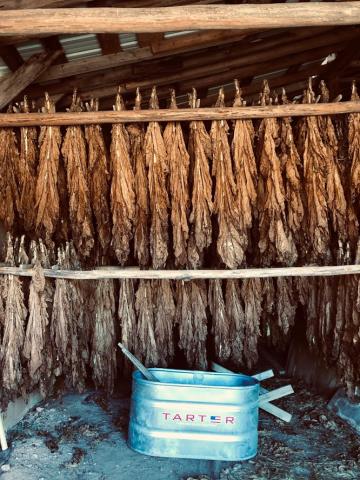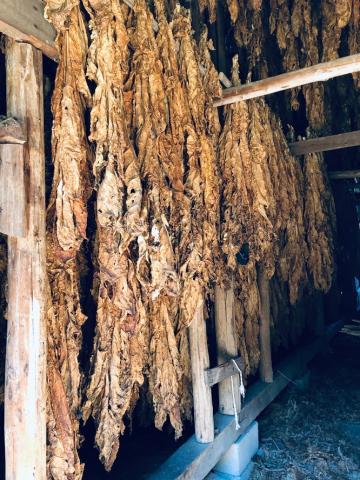Tharps Harvest Last Crop of Tobacco in Union County
Tobacco once was a way of life and a tradition. It is where people came from and how they grew up. A lot of hard work and pride went into the crop, but over the years it has become a dying tradition for many reasons, with little remaining in East Tennessee.
In Union County, Tennessee, a place where tobacco once flourished all through the hills and hollers in late summer months, one family harvested the county’s last crop of tobacco this season. James and Lora Tharp of Luttrell have raised the crop on their farm since they were married twenty-six years ago, and raised it with their families when they were growing up.
They live on the Tharp family farm of twenty-five acres and they lease another approximately fifty acres. They grow a plentiful garden and raise cattle, hay and tobacco. With just their own hands, they invest long hours and a lot of sweat to get all the work in. It is a daylight-to-after-dark job some days.
This year the couple grew just over an acre of tobacco, reduced from past years' average of about three acres. As far as can be told, this operation is the last of tobacco farms in Union County and one of the last of a few remaining tobacco growers in East Tennessee. A few folks in the county, including the Ray Family, grow a couple rows in their garden to make homemade chewing tobacco, but it seems the Tharps are last to grow commercially.
Tobacco farming is true manual labor that entails long hours in hot weather. It is not for the weak.
For a crop of tobacco, the season nowadays begins with purchasing plants from a greenhouse, usually near mid-May, to get them set out. In the past the Tharps, like many others, would grow their own plant beds. It would start with piling up brush and burning it where the beds would be placed. Eventually, like most, they starting using greenhouse plants. David Coppock and Dale Corum grew a lot of the plants locally then, but recently Tharp has bought from a farm in Athens, Tenn.
The plants are cultivated until mid-July when the buds begin to bloom and then it is topped. Topping the plants is done so the nutrients will stop going up, and the energy is directed back into the leaf, making a thicker, heavier leaf, which gives the grower what they are looking for: weight.
After topping, it is typically three to four weeks until time to harvest. Depending upon the variety, it takes until the last week of August or first week of September for it to mature.
How long the tobacco is in the field has a whole lot to do with the weather. Cutting was early this year because of the hot dry weather. The crop is then hung and cured.
Old folks would not start grading it until the first frost, which is what James goes by for the most part as well.
Over the years, the market for tobacco has changed. It used to be sold at auction. Every farm had a quota and sold that amount at auction. They were only allowed to grow that quota unless poundage was bought from someone else, usually for about fifty cents a pound. In the 2002 Tobacco Buyout, the market changed to require farmers to have a contract with a tobacco company in order to sell. Farmers would just take it to the receiving station and come back home with a check. In the buyout, the tobacco companies bought out the quotas. This plays a part in why there is a shortage and many are no longer growing.
Prices on the market have varied over the past four to five years. Overall though it is still bringing almost the same as in 2002; about $2 per pound. Tharp even remembers selling some in 1995 for $2.05 a pound, which is not a large variance in market price.
There are more options for selling if no contract is present. There is an auction barn in Kentucky and one in North Carolina. At auction, crops are bringing $1.40 -1.50 compared to $2.00 from the companies. Unless you have crop insurance, you cannot profit at that price, but crop insurance will guarantee a certain amount per pound per acre.
The tobacco is graded the same as it once was when it was more popular; RJ Reynolds looks for three grades: ground leaves, long reds, and tips, while Phillip Morris wants four grades. Tharp grows the same variety that he grew back in the 90’s when it came out, Tennessee 90. He says that he has tried several other varieties over the years, but continues to see consistency from the Tennessee 90 that he did not experience with some of the others.
Cure color is very important when it comes to selling. The buyers look for a deep dark color when cured out. Darker tends to have more nicotine and a less bitter flavor, Tharp shared.
Both James and Lora are from Union County. He grew up on the farm growing tobacco and has continued through the years. Her dad and grandparents were sharecroppers. James grew his first crop when he was fourteen and always helped his uncles and family as he was growing up. His granddaddy, who originally bought the farm, grew the crop as well, and it may go back even further in generations.
The Tharps use a tractor setter now, but in olden days his granddaddy used an old-time hand setter. Tharp says past generations used a team of horses to work the ground. The first tractor setter was bought by his granddad and neighbor, Tolbert Atkins, together.
Along with hard work are good, but backbreaking, memories. Tharp says he remembers fooling with tobacco since he was just a little fellow, when he was old enough to pull weeds out of the tobacco beds. “Hard work is all I can ever remember about it,” he says.
Several factors led to the decision to make 2019 the Tharps' final season of growing. Tharp said, “The sure fact that you can’t find help” is a big reason; along with regulation becoming increasingly strict. Over the last seven or eight years, farmers were required to go every year and update their Good Agriculture Practices (GAP) training, which the tobacco companies require. It is not just going to the class for a couple hours anymore.
Now, periodically, farms are chosen for a visit where records are reviewed and critiqued, and a $600 fee is charged to that individual. Although crediting accountability and regulation, that kind of fee for small producers cuts a huge amount from profits. This alone moves many of the smaller operations out.
It is easy to see the beauty and heritage of the tobacco tradition in Tennessee, but clear as to why it is a dwindling crop as well. James and Lora Tharp have been loyal to their heritage, and their love for agriculture shines in the other endeavors they continue to practice on their family farm in Luttrell.
- Log in to post comments


